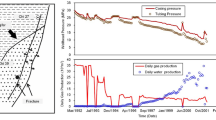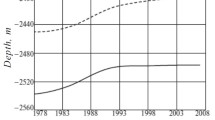We have developed a physical simulation model for gas injection/withdrawal consistent with the characteristics of water-encroached (flooded) underground storage facilities and we have simulated the construction and operation of the storage facility. Based on the operating schedule for the flooded underground gas storage and the mechanism for gas and water percolation in the flooded reservoir, we determined the important characteristics of flooded storage facilities including porosity, degree of flooding, and degree of heterogeneity of the reservoir as well as the operating scheme. We found that the degree of flooding and the heterogeneity of the reservoir are the crucial parameters for flooded storage facilities. We show that homogeneous reservoirs should be used as the main target layer of an underground gas storage facility. The water content in the reservoir must be taken into account during injection and withdrawal of gas from the storage facility.









Similar content being viewed by others
References
D. Kanaga, “Underground gas storage: Issues beneath the surface,” in: 2004 SPE Asia Pacific Oil & Gas Conference and Exhibition, Perth, Australia, 18-20 October 2004 (2004), SPE 88491.
A. I. Evernos and A. G. Comer, “On the feasibility of pressure relief by water removal during development and operation of gas storage in aquifers,” in: 47th Annual Fall Meeting of the Society of Petroleum Engineers, San Antonio, Texas USA, 8-11 October 1972 (1972), SPE 4308.
Z. Wang and S. A. Holditch, “Comprehensive parametric simulation study of the mechanisms of a gas storage aquifer,” Petroleum Society, 1–8 (2005).
D. M. Fourmaintraux, A. P. Bois, and C. L. Goff, “Detailed in situ stress measurements for qualifying the safety of underground gas storage overburden,” in: 67th EAGE Conference & Exhibition Incorporating SPE EUROPEC, Feria de Madrid, Spain, 13-16 June 2005 (2005), SPE 94253.
Y. T. Hamade, “Experimental study of formation behavior in underground storage,” in: Regional Gas Technology Symposium of the Society of Petroleum Engineers of AIME, Omaha, Nebraska, 7-9 June 1978 (1978), SPE 7164.
W. K. Sawyer, S. A. Holditch, M. D. Zuber, and A. D. Bues, “Reservoir simulation and analysis of the Sciota aquifer gas storage pool,” in: SPE Eastern Regional Meeting Conference and Exhibition, Pittsburgh, Pennsylvania, 9-11 November, 1998 (1998), SPE 51042.
Y. Qian, R. A. Wattenbarger, and L. Stuart, “Aquifer gas injection offers an alternative for handling associated gas produced from deepwater fields,” in: Offshore Technology Conference, Houston, Texas USA, 3-6 May 2004 (2004), OTC 16254.
J. A. Billiotte, H. De Moegen, P. Oren, “Experimental micromodeling and numerical simulation of gas/water injection/withdrawal cycles as applied to underground gas storage,” in: 65th Annual Technical Conference and Exhibition of the Society of Petroleum Engineers, New Orleans, Louisiana USA, 23-26 September, 1990 (1990), SPE 20765.
J. Ory, K. Guedeney, B. Brefort, and L. Schirrer, “A semi-automatic history matching technique applied to aquifer gas storages,” in: SPE Annual Technical Conference and Exhibition, San Antonio, Texas USA, 5-8 October, 1997 (1997), SPE 38862.
Z. Chen, X. Wu, and D. Sun, “Study on relationship between permeability of sandstone and hydrostatic pressure,” Chinese Journal of Rock Mechanics and Engineering, No. 2, 155–159 (1995).
Y. He and L. Yang, “Testing study on variational characteristics of rock mass permeability under loadingunloading of confining pressure,” Chinese Journal of Rock Mechanics and Engineering, No. 3, 415–419 (2004).
R. Azin, A. Nasiri, and A. J. Entezari, “Investigation of underground gas storage in a partially depleted gas reservoir,” in: Canadian International Petroleum Conference SPE Gas Technology Symposium, Calgary, Canada, 16-19 June 2008 (2008), SPE 113588.
Author information
Authors and Affiliations
Additional information
Translated from Khimiya i Tekhnologiya Topliv i Masel, No.6, pp. 11 – 15, November – December, 2011.
Rights and permissions
About this article
Cite this article
Shi, L., Gao, SS. & Xiong, W. Physical simulation of the mechanism for operation of water-encroached (flooded) underground gas storage facilities. Chem Technol Fuels Oils 47, 426–433 (2012). https://doi.org/10.1007/s10553-012-0319-2
Published:
Issue Date:
DOI: https://doi.org/10.1007/s10553-012-0319-2




